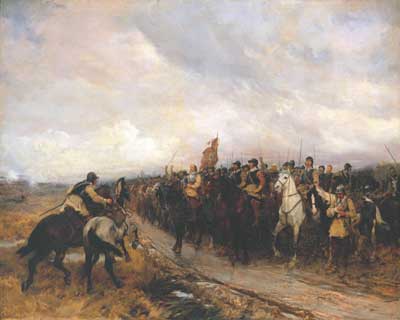1650 – Battle Of Dunbar
The Calvinists were in support of Charles II when he became King and signed both the Covenants in 1649. Cromwell, however, was not. With sixteen thousand men he invaded Scotland in July and headed for Edinburgh, expecting to rendezvous with his supply ships at Leith. David Leslie and the Scots army did not let him.
By August Cromwell had backtracked to Dunbar. As the Scots followed, Covenanting ministers dismissed from among them any who did not meet their godly standards. Least satisfactory were the professional soldiers, most of whom were told to leave, and Leslie’s force dropped by five thousand, leaving what was described by an appalled officer as ‘an army of clerks and ministers’ sons’.
Even so, by September Cromwell’s men were pushed up against the sea at Dunbar with no sign of their supplies, and with their premium position on Doune Hill above, the Scots had only to wait for the already weak enemy to surrender.
Patience was not among the fervent ministers’ virtues. Ignoring Leslie and knowing nothing of military tactics, they sent his twenty thousand men down the hill.
It was the consummate military blunder.
Three thousand were killed and ten thousand captured. Edinburgh Castle belonged to Cromwell by December.
The Aftermath of The Battle Of Dunbar
The Death March to Durham
The aftermath of the 1650 Battle of Dunbar saw the grave mistreatment of 5,000 Scottish prisoners-of-war at the hands of the English Parliamentarian army. These battle-weary prisoners were starved of food and sleep, whilst at the same time force-marched over 100 miles to a makeshift prison in hellish conditions. Yet this is one of the least known stories of the civil war that raged across the whole of Britain, probably not surprising as it leaves such a black mark on England’s military history. ScotClans was contacted by a relative of one of the handful survivors of this terrible event which has led us to research the so named ‘Death March to Durham’.
» Continue to read about the Death March to Durham







